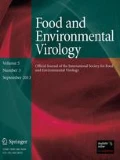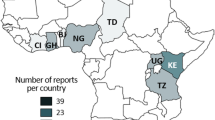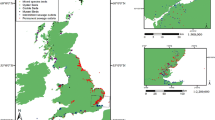Abstract
Two outbreaks of norovirus and acute gastroenteritis took place in Canada between November 2016 and April 2017. Both outbreaks were linked to oysters from British Columbia (BC) coastal waters. This paper describes the multi-agency investigations to identify the source and control the outbreak. Public health officials conducted interviews to determine case exposures. Traceback was conducted by collecting oyster tags from restaurants and analyzing them to determine the most common farms. Oyster samples were collected from case homes, restaurants, and harvest sites and tested for the presence of norovirus. Potential environmental pollution sources were investigated to identify the source of the outbreak. Four hundred and 49 cases were identified as part of the two outbreak waves. The oysters were traced to various geographically dispersed farms in BC coastal waters. Twelve farms were closed as a result of the investigations. No environmental pollution sources could be identified as the cause of the outbreak. Similarities in the timeframe, genotype, and geographic distribution of identified oyster farms indicate that they may have been one continuous event. Genotype data indicate that human sewage contamination was the likely cause of the outbreak, although no pollution source was identified.



Similar content being viewed by others
References
Alfano-Sobsey, E., Sweat, D., Hall, A., Breedlove, F., Rodriguez, R., Greene, S., et al. (2012). Norovirus outbreak associated with undercooked oysters and secondary household transmission. Epidemiology and Infection, 140(2), 276–282. https://doi.org/10.1017/S0950268811000665.
Cabelli, V. J. (1998). Microbial indicator levels in shellfish, water, and sediments from the upper Narragansett Bay condional shellfish-growing area. Report to the Narragansett Bay Project, Providence, R.I..
Dam Rasmussen, L., Schultz, A. C., Uhrbrand, K., Jensen, T., Kølsen Fischer, T., Rasmussen, L. D., et al. (2016). Molecular evidence of oysters as vehicle of norovirus GII.P17-GII.17. Emerging Infectious Diseases, 22(11), 2024–2025. https://doi.org/10.3201/eid2211.161171.
David, S. T., McIntyre, L., MacDougal, L., Kelly, D., Liem, S., Schallie, K., et al. (2007). An outbreak of norovirus caused by consumption of oysters from geographically dispersed harvest sites, British Columbia, Canada, 2004. Foodborne Pathogens and Disease, 4(3), 349–358. https://doi.org/10.1089/fpd.2007.0015.
DiGirolamo, R., Liston, J., & Matches, J. R. (1970). Survival of virus in chilled, frozen, and processed oysters. Applied and Environmental Microbiology, 20(1), 58–63.
FPT Food Safety Committee (2016). Food Retail and Food Services Code. Health Canada FPTFSC Secretariat, Health Products and Food Branch, Food Directorate. (Ed.).
Health Canada. (2002). Enumeration of coliforms, faecal coliforms and of E. coli in foods using the MPN method. The Compendium of Analytical Methods, 2, MFHPB–M19.
Hewitt, J., & Greening, G. E. (2006). Effect of heat treatment on hepatitis A virus and norovirus in New Zealand greenshell mussels (Perna canaliculus) by quantitative real-time reverse transcription PCR and cell culture. Journal of Food Protection, 69(9), 2217–2223.
International Organization for Standardization (2013). ISO 15216 Microbiology of the food and animal feed—Horizontal method for determination of hepatitis A virus and norovirus in food using real-time RT-PCR- Part 1: Method for quantification.
Karst, S. M. (2010). Pathogenesis of noroviruses, emerging RNA viruses. Viruses, 2(3), 748–781. https://doi.org/10.3390/v2030748.
Kirkland, K. B., Meriwether, R. A., Leiss, J. K., & Mac Kenzie, W. R. (1996). Steaming oysters does not prevent Norwalk-like gastroenteritis. Public Health Reports, 111(6), 527–530.
Le Guyader, F. S., Atmar, R. L., & Le Pendu, J. (2012). Transmission of viruses through shellfish: When specific ligands come into play. Current Opinion in Virology, 2(1), 103–110. https://doi.org/10.1016/j.coviro.2011.10.029.
Le Guyader, F. S., Bon, F., DeMedici, D., Parnaudeau, S., Bertone, A., Crudeli, S., et al. (2006a). Detection of multiple noroviruses associated with an international gastroenteritis outbreak linked to oyster consumption. Journal of Clinical Microbiology, 44(11), 3878–3882. https://doi.org/10.1128/JCM.01327-06.
Le Guyader, F. S., Loisy, F., Atmar, R. L., Hutson, A. M., Estes, M. K., Ruvoen-Clouet, N., et al. (2006b). Norwalk virus-specific binding to oyster digestive tissues. Emerging Infectious Diseases, 12(6), 931–936.
McIntyre, L., Galanis, E., Mattison, K., Mykytczuk, O., Buenaventura, E., Wong, J., et al. (2012). Multiple clusters of norovirus among shellfish consumers linked to symptomatic oyster harvesters. Journal of Food Protection, 75(9), 1715–1720. https://doi.org/10.4315/0362-028x.jfp-12-113.
McIntyre, L., Galanis, E., Prystajecky, N., & Kosatsky, T. (2017). BC oysters and norovirus: Hundreds of cases in months with an “r”. BCMJ, 59(6), 2.
Public Health Agency of Canada. (2015). Foodbook Report. Centre for Food-borne, Environmental, and Zoonotic Infections Diseases, Infectious Diseases Prevention and Control Branch, Public Health Agency of Canada (Ed.).
Richards, G. P., McLeod, C., & Le Guyader, F. S. (2010). Processing strategies to inactivate enteric viruses in shellfish. Food and Environmental Virology, 2(3), 183–193. https://doi.org/10.1007/s12560-010-9045-2.
Schwab, K. J., Neill, F. H., Estes, M. K., Metcalf, T. G., & Atmar, R. L. (1998). Distribution of Norwalk virus within shellfish following bioaccumulation and subsequent depuration by detection using RT-PCR. Journal of Food Protection, 61(12), 1674–1680.
Smith, A., McCarthy, N., Saldana, L., Ihekweazu, C., McPhedran, K., Adak, G., et al. (2012). A large foodborne outbreak of norovirus in diners at a restaurant in England between January and February 2009. Epidemiology and Infection, 140(09), 1695–1701.
Symes, S. J., Gunesekere, I. C., Marshall, J. A., & Wright, P. J. (2007). Norovirus mixed infection in an oyster-associated outbreak: An opportunity for recombination. Archives of Virology, 152(6), 1075–1086. https://doi.org/10.1007/s00705-007-0938-9.
Thomas, M. K., Murray, R., Flockhart, L., Pintar, K., Pollari, F., Fazil, A., et al. (2013). Estimates of the burden of foodborne illness in Canada for 30 specified pathogens and unspecified agents, circa 2006. Foodborne Pathogens and Disease, 10(7), 639–648. https://doi.org/10.1089/fpd.2012.1389.
Tian, P., Engelbrektson, A. L., Jiang, X., Zhong, W., & Mandrell, R. E. (2007). Norovirus recognizes histo-blood group antigens on gastrointestinal cells of clams, mussels, and oysters: A possible mechanism of bioaccumulation. Journal of Food Protection, 70(9), 2140–2147.
Verhoef, L., Vennema, H., van Pelt, W., Lees, D., Boshuizen, H., Henshilwood, K., et al. (2010). Use of norovirus genotype profiles to differentiate origins of foodborne outbreaks. Emerging Infectious Diseases, 16(4), 617–624. https://doi.org/10.3201/eid1604.090723.
Wang, J., & Deng, Z. Q. (2016). Modeling and prediction of oyster norovirus outbreaks along Gulf of Mexico coast. Environmental Health Perspectives, 124(5), 627–633. https://doi.org/10.1289/ehp.1509764.
Webby, R. J., Carville, K. S., Kirk, M. D., Greening, G., Ratcliff, R. M., Crerar, S. K., et al. (2007). Internationally distributed frozen oyster meat causing multiple outbreaks of norovirus infection in Australia. Clinical Infectious Diseases, 44(8), 1026–1031. https://doi.org/10.1086/512807.
Westrell, T., Dusch, V., Ethelberg, S., Harris, J., Hjertqvist, M., Jourdan-da Silva, N., et al. (2010). Norovirus outbreaks linked to oyster consumption in the United Kingdom, Norway, France, Sweden and Denmark. Euro Surveill, 15(12), 19524.
Acknowledgements
The authors would like to acknowledge the contributions of Mieke Fraser (BCCDC), Gloria Yu (VIHA), Richard Greve (VIHA), Stephanie Bruvall (VIHA), Charlene MacKinnon (VIHA), Virginia Jorgensen (VCH), Serena Lai (VCH), Cicely Yang (VCH), Joyce Cheng (PHAC), Shiona Glass-Kaastra (PHAC), Emma Cumming (PHAC), Rashmi Narkar (McGill University), Victor Mah (Alberta Health), Alanna Fitzgerald-Husek (PHO), Public Health Ontario Provincial Laboratory, Toronto Public Health, York Region Health Service, Durham Region Health Department, CFIA Burnaby Laboratory, CFIA St-Hyacinthe Laboratory, CFIA Pacific Shellfish, and all CFIA Inspectors, Environmental Health Officers, and Medical Health Officers who were involved in case investigation. Outbreak team includes Enrico Buenaventura (Health Canada), Kelsie Dale (Alberta Health Services), Samara David (British Columbia Centre for Disease Control), Mohammed Elmufti (Canadian Food Inspection Agency), Katie Eloranta (Canadian Food Inspection Agency), Charmaine Enns (Vancouver Island Health Authority), Tara Hluchy (Alberta Health Services), Blair Holmes (Environment and Climate Change Canada), Lance Honish (Alberta Health Services), Corey Kan (Alberta Health Services), Kristen Kirby (Canadian Food Inspection Agency), Paul Kirkby (Canadian Food Inspection Agency), Stephanie Konrad (Public Health Agency of Canada), Gabrielle Kosmider (Department of Fisheries and Oceans), Amalia Martinez (Health Canada), Xiaoli Pang (Alberta Health Services), Jackie Plamondon (Canadian Food Inspection Agency), Frankie Tsang (BCCDC Public Health Laboratory), and Emilie Turgeon (Health Canada).
Funding
The authors have no sources of funding to disclose.
Author information
Authors and Affiliations
Consortia
Corresponding author
Ethics declarations
Conflict of interest
The authors have no conflicts of interest to disclose.
Ethics Approval and Consent to Participate
This work was not submitted for an ethics review as it was conducted for the purpose of outbreak investigation and control.
Additional information
Publisher’s Note
Springer Nature remains neutral with regard to jurisdictional claims in published maps and institutional affiliations.
Rights and permissions
About this article
Cite this article
Meghnath, K., Hasselback, P., McCormick, R. et al. Outbreaks of Norovirus and Acute Gastroenteritis Associated with British Columbia Oysters, 2016–2017. Food Environ Virol 11, 138–148 (2019). https://doi.org/10.1007/s12560-019-09374-4
Received:
Accepted:
Published:
Issue Date:
DOI: https://doi.org/10.1007/s12560-019-09374-4




